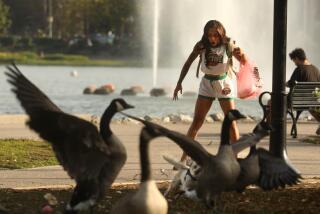The Geese Return : Census Finds More Than Ever, Despite Ruffled Feathers Over Basin Work
- Share via
The cry of the wild goose should be easier to hear in the San Fernando Valley this winter.
There are more of them.
Despite the fears of some environmentalists that changes to the Sepulveda Basin would drive away the Canada geese that are one of the Valley’s most spectacular seasonal sights, a goose census counted more of the big birds than ever.
Some environmentalists, however, are still skeptical, fearing that work on the basin will drive the birds away. The Army Corps of Engineers, which owns the basin, says those fears apparently are groundless.
Flocking to the Valley
The geese, which spend the warmer months in the lake country of northern Canada, return to the Valley each fall to spend the winter. They can often be seen in flocks of hundreds, strung out in V formations, honking raucously as they fly between sleeping and feeding areas.
Each Dec. 26, the Valley chapter of the Audubon Society conducts a bird census. Squads of bird-watchers fan out to sites throughout the area to count certain species of birds, including the wild geese.
The post-Christmas count this year came up with 3,266 geese at four sites, a 20% increase from the previous high of 2,727 in 1984.
That continued an upward trend. In 1985, 2,041 geese were tallied, and in 1986 the count was 2,449.
The geese are counted each year at the Sepulveda Basin, the Encino Reservoir, the Chatsworth Reservoir and the cornfields of Pierce College. Sharp decreases at some locations usually corresponded to comparable increases elsewhere, showing that the geese, which like to sleep on water but feed on land, preferred some locales to others at the hour the count was made.
The count in the Sepulveda Basin dropped from 473 last year to 363 this year, but the tally at Chatsworth Reservoir shot up from 920 to 2,428.
Opponents of development in the Sepulveda Basin have raised fears that the geese were being driven away by changes there.
The Corps of Engineers is converting 160 acres of farmland into Bull Creek Park, which will include a 26-acre lake. An arts park with a concert hall and amphitheater has been proposed for 60 acres of the site.
The land, which for years had been cornfields where the geese fed, has been temporarily leased to a sod grower. Work will begin on earth-moving operations to scoop out the lake bed as soon as the soil dries from the rains.
Wildlife-Management Site
After environmentalists expressed worry to the corps about foraging grounds for the geese, the engineers leased 60 acres to a corn farmer to serve as a wildlife-management area, in part as a replacement for the lost cornfields beside Balboa Boulevard. The area is bounded by Burbank Boulevard, the Ventura Freeway, the Los Angeles River and Hjelte Park.
The Audubon Society count, however, turned up no geese in the “wildlife management” tract, said Dr. Stephen Ducatman of Woodland Hills, an Audubon Society leader.
“I can’t help but feel that, since their major forage areas are being changed by development of the so-called wildlife area, that they are confused, the way people would be if we closed all the restaurants they knew about,” said Jill Swift of the Sierra Club.
“Their genetic memories bring them back here, but all they find is huge machines where they are accustomed to forage, but nothing to eat,” she said.
Such worries underestimate the geese’s flexibility, said Tom Walsh, West Valley District superintendent for the Los Angeles Department of Animal Regulation.
“The geese aren’t just dependent on the Sepulveda Basin corn crop,” he said. “They can survive on grass for quite a while,” he said, and have no problems seeking out new feeding grounds. “They seem to be able to sustain themselves quite well,” he said.
“The geese haven’t been using the wildlife-management area because they have plenty of other places to go,” said Sheila Murphy, the corps’ project manager for the Sepulveda Basin recreational area.
“We had a meeting not long ago with the Audubon Society and our staff biologists to talk about this. We’re still studying how the development affects the geese. We wanted to get through this season and see how it went.
Numbers Are Usual
“Well, the count shows we’re getting at least as many geese as we always did, and they can forage on what they have. There are places where even more geese than we have in the basin live on fewer acres of forage.”
The geese cluster at Chatsworth Reservoir, which has only a small pond of water, because of the grass shoots they find there and because the land is open, said Arthur Langton, president of the Valley chapter of the Audubon Society.
“They like big, open fields where they can see a long ways around them to make sure nothing is sneaking up on them,” he said.
Even though the census found far more geese at Chatsworth Reservoir than had ever been counted--almost twice the 1,234 in 1985 that was the previous high--his personal observations of the flock do not bear out a conclusion that there are more there than in previous years, Walsh said.
“I’ve seen even more there than we have this year,” Walsh said, although he added that it is impossible for an observer to distinguish between the birds that spend the winter in the Valley and other flocks that are just resting briefly before continuing south to winter homes in Mexico.
“I don’t think we’re going to have a problem. We’re going to have the geese here for a long time.”
More to Read
Sign up for Essential California
The most important California stories and recommendations in your inbox every morning.
You may occasionally receive promotional content from the Los Angeles Times.













